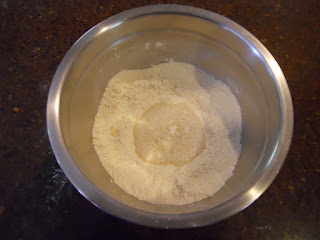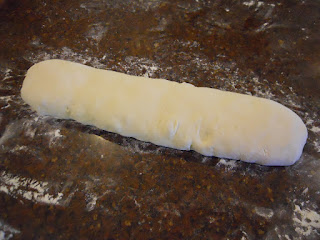If you visited my Picasa Web Albums or my "MorfiChupi" album pictures on Facebook, you probably noticed that I really enjoy cooking. The passion for food and cooking seems to be in our family's genes, my dad is passionate about it, and let me tell you he is an amazing cook, for some time he had a small deli in Buenos Aires. My two brothers are also masters in the kitchen, they both went to culinary schools, and my youngest brother still works at a pasta factory. When I was a bambino my grandma with her cousins owned one of the best and most traditional Italian restaurants in downtown Buenos Aires (Il Napoli, across the Luna Park stadium).
My grandparents were from Italy, and I remember when we all got together every Sunday for the classic Italian family feast. The process started early in the morning since everything was home made from scratch, the breads, antipasto, spaghetti, ravioli, meats, salads, desserts, well you get the picture.
When I get on the kitchen to cook, it is like therapy, it lets me disconnect from the brain intensive geeky programming or electronics design work I do. It also brings back those pleasant memories of my family and those fantastic Sunday meals.
If there is something that I always die for is good bread, better said, artisan breads, in particular Italian and French breads. I won't deny that some of the chain or supermarket bakeries have good products, but there is nothing better and close to an artisan bread that the one home made with your own hands.
To make some basic breads the process is very simple and with few steps, measure, mix, knead, raise, punch, form, proof, bake, cool, eat.
I won't get to much on the details and basic concepts and techniques of bread making but I'll recommend you one of my favorite books:
Ultimate Bread
by Eric Treuille & Ursula Ferrigno
What is interesting is that while the book is printed in Great Britain, Eric was born in France and he started very young working at his uncle's boulangerie (bakery shop), and Ursula was born in Italy and grew up on her father's farm in southern Italy.
The book takes you from the fundamentals of breadmaking and the essentials techniques with plenty of great pictures and includes over 100 recipes for many different types of breads.
In a future article I'll share some comments about other breadmaking books I've and that are among my favorite cooking books.
Wanna get started ? Nothing better than a simple recipe to make a plain bread, what in France is called Pain Ordinaire or Pane Rustico in Italy.
What do you need:
- 1 small pack (4oz) or 2tsp of dry yeast
- 1 1/2 cups of water
- 3 1/2 cups of unbleached bread flour
- 1 1/2 tsp salt
You obviously start by measuring and mixing the ingredients.
On a measuring cup put about 1/8 cup (125ml) of warm water and sprinkle the yeast in. If the ambient temperature is too low you can drop a little pinch of sugar to get the yest fermentation process going, stir until the yeast is dissolved and put away for 5-10 minutes.
Meanwhile mix the flour and salt in a bowl, you will get better results if you stiff the flour before.
Make a well like a crater in the center of the flour and pour the dissolved yeast.
With a wooden spoon start mixing slowly some of the flour on the side until you have a creamy gooey paste combining the dissolved yeast with the surrounding flour.
This is called "the sponge method."
Now cover the bowl with a kitchen towel and put away for about 20 minutes.
You will notice that the yeast and flour gooey expanded and became frothy with some holes from bubbles created by the yeast.
Very gradually and mixing with the wooden spoon start incorporating the rest of the water into the center and mix the flour from the side, it will slowly start to form a moist dough.
If you need to add more water to get a firm dough, add one tablespoon at a time.
Don't worry if the dough is sticky and look very moist, its better to have a moist dough than a dry dough.
Time to put some muscle. Take out the dough from the bowl into a lightly floured surface, go easy with the flour since we are only using it to have a non stick surface so we can knead the dough.
Knead for 10 minutes, if you feel that the dough is too difficult to handle, knead for 5 minutes, let it rest for 5 minutes and knead for another five, until you get a smooth and elastic dough.
When you are done kneading, put the dough ball on a clean bowl, cover with a kitchen towel and put on a warm place (not hot !! we don't want to cook it).
We'll let it rise until it doubles in size, depending on temperature and other conditions it make take about 1 1/2 to 2 hours.
Magic !! now we have twice or more the original size, but full of bubbles.
Very gently make a fist and with your knuckles slowly punch down the dough to release some of the gas that formed inside.
After you punch it down let it rest for 10 minutes.
Now is time to give our bread some form, in this case we will do a long wide loaf.
Take the dough out of the bowl, gently spread forming sort of a rectangle and fold from the side 1/3 to the center.
Now fold the other side to the center.
Very gently with your palm start pressing to seal the two folds in the middle.
Then with your thumbs create a small indentation in the middle to finish sealing the union.
Turn the loaf over and with your hands keep forming the loaf extending until it gets to about 15" long. Put the shaped loaf on a floured baking pan, cover with a dish towel and let it proof until it doubles in size.
It may take 30 to 45 minutes. Depending on how long it takes your oven to warm up, you can start preheating it to 425 F.
An easy way to determine if the proofing is done, is to push gently with your finger the center of the loaf, if the dough springs back slowly you are golden, if it is too firm bad luck but don't worry it is still edible, but don't over proof it, it is preferred to put it early than late in the oven.
Before you put the loaf in the oven, cut some slashes on the top, it is not just for decoration, it helps the dough to expand without generating cracks on the sides or the bottom. Put it in the oven and let it bake until golden (30-45 minutes).
Don't open the oven every five minutes !!!
When I do this type of rustic breads I like to use a nice trick to create some additional moisture and obtain a more crunchy crust, open the oven and spray the loaf with a mist of salty water.
Let the loaf fully cook. Uncooked bread can give you an indigestion.
An easy trick for this type of breads to find out if they are cooked or not, is to turn them over and knock in the underside, if it sounds like nobody is home (slightly hollow) your bread is done.
When you take it out of the oven let it cool on a wire rack or grill, if you leave it in a flat surface the bottom will become soggy.
WAIT !! until it cooled down to cut.
Voilà, you just made your first Pain Ordinaire.
Next recipe ? Jorge's mega-bagels
Enjoy !!
Jorge

















No comments:
Post a Comment